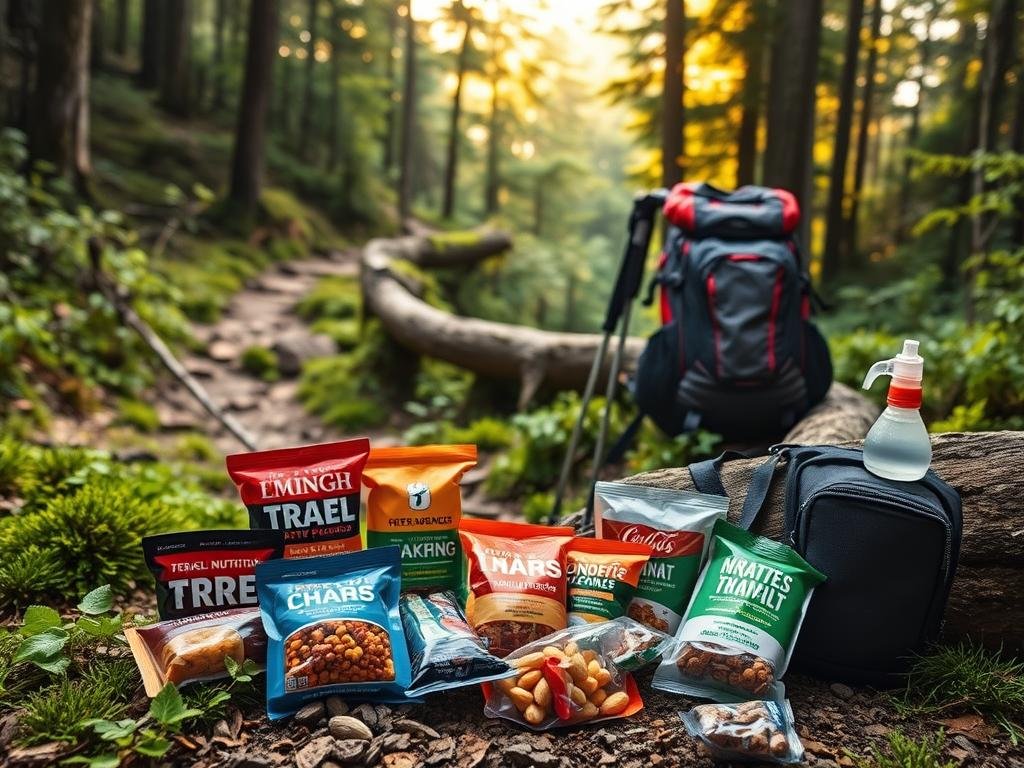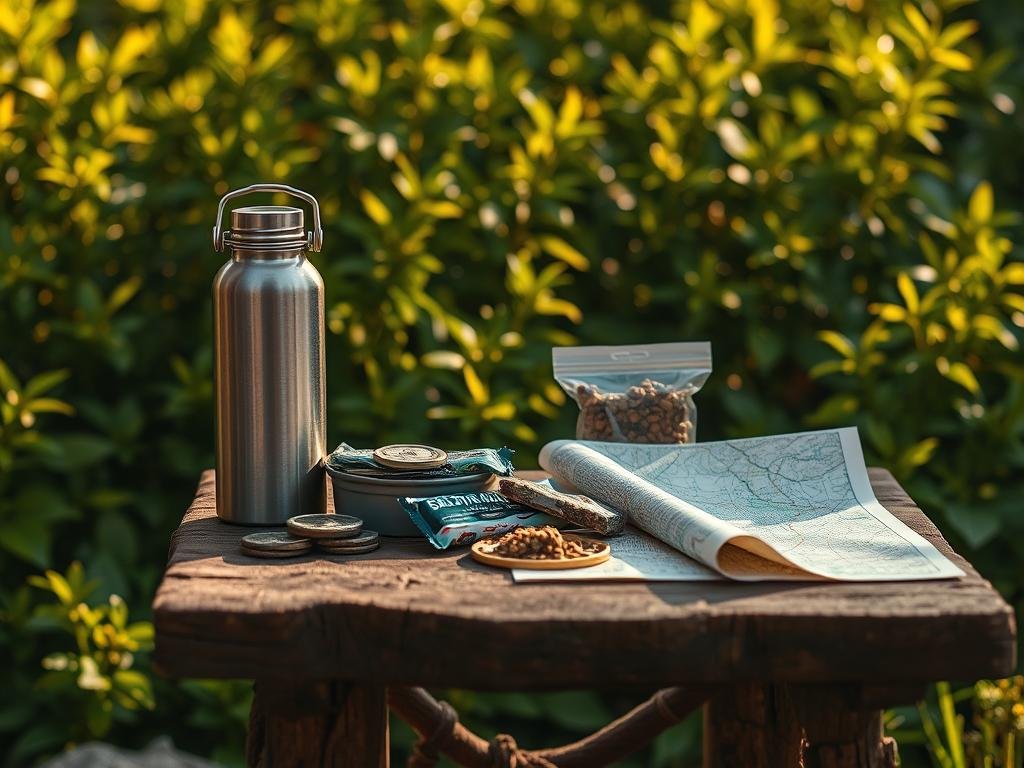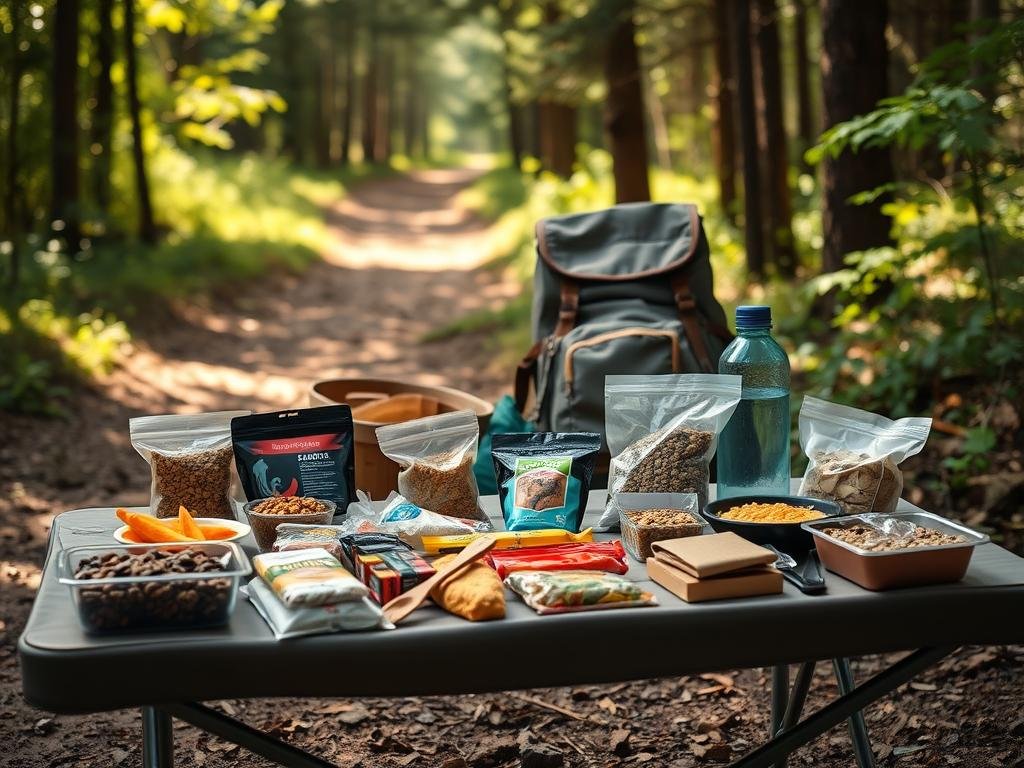Proper nutrition is the secret weapon for outdoor enthusiasts. It keeps energy levels steady and prevents sudden fatigue, often called “bonking.” A balanced diet helps maintain stable blood sugar, ensuring you stay strong on the trail.
Paula’s 99-pound weight loss journey shows how food choices transform performance. Her story highlights the real-world impact of smart fueling. Eating right reduces muscle fatigue and boosts endurance.
Timing matters. A breakfast with 7g protein, 30g carbs, and healthy fats sets the tone. Snacks like nuts or dried fruit sustain energy during activity. Hydration is equally vital—sipping water with electrolytes maintains fluid balance.
Table of Contents
Key Takeaways
- Balanced meals prevent energy crashes during hikes.
- Protein aids muscle recovery after activity.
- Hydration with electrolytes supports endurance.
- Whole-food carbs provide lasting fuel.
- Meal timing optimizes performance.
Why Proper Nutrition is Key for Hiking Performance
Smart fueling transforms outdoor adventures from exhausting to exhilarating. The right foods power every step, while poor choices lead to energy crashes and muscle strain.

How Food Fuels Your Body on the Trail
Your body operates like an engine, burning carbs and fats for movement. During moderate activity, it uses 70% fat and 30% carbs for steady energy. Complex carbohydrates provide lasting fuel, while refined sugars cause spikes and crashes.
Glycogen stores act as your energy reserve. The body holds 300-600 grams, enough for 2-3 hours of intense activity. Once depleted, fatigue sets in—known as “bonking.” Consuming 60-90 grams of carbs hourly prevents this during long treks.
| Nutrient | Role | Recommended Intake |
|---|---|---|
| Carbohydrates | Primary energy source | 60-90g/hour (long hikes) |
| Protein | Muscle repair | 20g post-hike |
| Electrolytes | Hydration balance | 500mg sodium/hour |
The Risks of Poor Hiking Nutrition
Dehydration hits fast. Just 2% fluid loss reduces performance by 30%. Symptoms include dizziness and dark urine. Electrolyte imbalances worsen these effects, especially at high altitudes.
Muscle breakdown occurs without proper protein. Studies show Himalayan trekkers experienced severe soreness from inadequate recovery meals. Post-activity nutrition should include 20g protein and carb-rich foods to rebuild energy stores.
Poor food choices create inflammation. Processed snacks delay recovery and increase fatigue. For multi-day trips, balanced meals prevent muscle loss and maintain stamina. Learn more about endurance nutrition strategies for extended adventures.
Hike Longer and Stronger with These Nutrition Tips
Fueling your body correctly before, during, and after a trek makes all the difference. Strategic meals boost endurance, prevent crashes, and speed up recovery. Here’s how to optimize each phase.

Pre-Hike Fuel: Balanced Breakfast Ideas
Start with a 2:1 carb-to-protein ratio. Avocado toast or chia oatmeal provides steady energy without bloating. Include 14–22 oz of water 2 hours beforehand to hydrate.
| Meal | Carbs (g) | Protein (g) | Benefits |
|---|---|---|---|
| Oatmeal + dried fruit | 50 | 10 | Sustained energy |
| Scrambled eggs + cheese | 5 | 20 | Muscle prep |
On-Trail Nutrition: Smart Snacking Strategies
Aim for 30–60g carbs hourly. Trail mix or nut butter packets deliver quick fuel. Electrolyte-rich snacks like salted nuts prevent cramps.
- Wildway granola: No added sugars, high in fiber.
- Chomps jerky: Portable protein (10g per serving).
Post-Hike Recovery: Meals for Muscle Repair
Rebuild glycogen with a 4:1 carb-protein ratio. A burger with sweet potato fries or stir-fry with rice works well. Berries and omega-3s reduce inflammation.
Insulin helps absorb nutrients faster post-activity. Pair meals with electrolyte drinks like Skratch Labs for hydration.
Essential Nutrients Every Hiker Needs
The right mix of nutrients powers endurance and recovery on rugged trails. Each macronutrient—carbs, protein, and fats—serves a unique purpose. Balancing them prevents fatigue and enhances stamina.

Carbohydrates: Your Primary Energy Source
Complex carbs like quinoa and steel-cut oats release energy slowly. They outperform processed bread, which spikes blood sugar. For long treks, aim for 60–90g hourly to avoid glycogen depletion.
| Carb Source | Glycemic Index | Trail Benefits |
|---|---|---|
| Quinoa | 53 (Low) | Slow energy release |
| White bread | 75 (High) | Quick but short-lived fuel |
Protein: Repairing and Rebuilding Muscles
Muscle repair requires 1.4–2.0g protein per kg of body weight daily. Leucine, found in animal and soy proteins, triggers muscle synthesis. Post-hike, pair 20g protein with carbs for optimal recovery.
- Cricket protein bars: Sustainable and packed with 10g protein per serving.
- Wildly Organic pecans: Deliver 3g protein per ounce plus healthy fats.
Healthy Fats: Sustained Energy for Long Treks
Avocados and olive oil provide omega-3s to reduce inflammation. Balance omega-3 and omega-6 intake to avoid joint stiffness. Nuts like pistachios offer portable, nutrient-dense fuel.
Pro Tip:Combine fats with carbs (e.g., nut butter on whole-grain crackers) for lasting energy.
Hydration Tips to Keep You Going Strong
Electrolyte balance separates thriving hikers from those battling fatigue. Proper fluid intake sustains energy and prevents dangerous drops in performance. Small amounts of carbohydrates help the body absorb fluid quickly during endurance activities.

How Much Water Should You Drink?
Baseline needs vary by climate and intensity. The Institute for Altitude Medicine recommends 1–1.5L extra at high elevations. Weigh yourself before and after activity—each pound lost equals 16 oz of fluid needed.
Pro Tip: Sip 24 oz of water or a hypotonic drink post-hike to replenish losses. Avoid caffeine beforehand—it acts as a diuretic, increasing dehydration risks.
Electrolytes: The Secret to Avoiding Fatigue
Sodium and potassium regulate fluid balance but vanish through sweat. Athletes lose up to 2 quarts hourly. Aim for 150–200mg sodium per 16 oz in sports drinks.
- Skratch Labs: Low-osmolality mix with 6–8% carbs for energy.
- Pedialyte® Sport: Higher electrolytes, lower sugar than typical brands.
Watch for confusion or dizziness—signs of hyponatremia. Balance sodium and potassium during multi-day trips to prevent cramps. Pair electrolytes with carbs for optimal absorption.
Trail-Friendly Meal Planning Made Easy
Smart meal planning turns grueling treks into enjoyable adventures. Pack lightweight, nutrient-dense foods to meet daily needs of 2,500–3,500 calories or 1.5–2.5 lbs per day. Balance convenience with nutrition to keep your pack light and energy high.

Lightweight, Nutrient-Dense Foods to Pack
Freeze-dried meals like Mountain House Chicken Dumplings offer quick calories but cost more than DIY options. For budget-friendly meals, try these swaps:
- Nuts vs. commercial bars: Almonds deliver 160 calories/oz—40% more than most bars.
- Vacuum-sealed grains: Quinoa cooks faster than rice and packs 22g protein per cup.
Balanced Meal Ratios for Optimal Energy
Aim for 50% carbs, 30% fats, and 20% protein. Himalayan yak barley soup combines grains, lean meat, and veggies for 450 calories per serving. For gluten-free hikers, swap barley with buckwheat.
| Trip Length | Food Weight | Top Ingredients |
|---|---|---|
| Weekend (2 days) | 3–5 lbs | Nut butter, jerky, dried fruit |
| 5+ days | 7.5–12.5 lbs | Dehydrated beans, oats, coconut milk powder |
Pro Tip: Pair lightweight backpacking gear with silicone bags for compact storage. Local foraging (e.g., berries in Pacific Northwest) adds fresh ingredients.
Best Snacks to Boost Your Hiking Energy
The right trail snacks can make or break your outdoor adventure. Portable, nutrient-dense options maintain energy without weighing down your pack. Focus on balanced macros and easy digestion for optimal performance.
Trail Mix: A Classic Energy Booster
Custom blends outperform store-bought versions with added sugars. The ideal mix contains 40% nuts, 30% seeds, 20% dried fruit, and 10% dark chocolate. Walnuts provide slow-digesting fiber for sustained energy.
| Ingredient | Calories/oz | Key Benefit |
|---|---|---|
| Almonds | 160 | Vitamin E for muscle recovery |
| Pumpkin seeds | 148 | Zinc for immunity |
| Dried apricots | 80 | Potassium to prevent cramps |
| Dark chocolate (70%) | 150 | Antioxidants reduce inflammation |
Nut Butter Packets: Quick and Convenient Fuel
Single-serve packets deliver concentrated energy without mess. Wildway cashew butter provides 7g protein per serving—ideal for long ascents. Compare options:
- Almond butter: Higher in vitamin E (7.3mg/oz) but more expensive
- Sunflower butter: Budget-friendly with comparable protein (6g/oz)
- Peanut butter: Most calories (190/oz) for weight-conscious hikers
Paula’s 50kcal protein balls combine nut butter with oats for portable energy. Mix 1 tbsp butter with ¼ cup oats and dark chocolate chips.
Fresh Fruit: Nature’s Energy Bars
Whole fruits offer natural sugars plus hydration. Himalayan yellow raspberries pack antioxidants rarely found in processed snacks. Choose these durable options:
- Apples: Last 3+ days unrefrigerated (95 calories medium)
- Oranges: Provide hydration + vitamin C (62 calories each)
- Bananas: Fast energy (105 calories) but bruise easily
Store in reusable silicone bags to prevent crushing. Avoid commercial dried fruits with added sugars exceeding 12g per serving.
Special Considerations for Dietary Restrictions
Dietary restrictions shouldn’t limit your outdoor performance. With the right ingredients, plant-based or allergy-friendly diets can fuel endurance just as effectively. Always check labels for vague terms like “flavoring” to avoid hidden allergens.
Vegetarian and Vegan Trail Nutrition
Quinoa is a powerhouse—it’s a complete protein with all nine essential amino acids. Pair it with lentils or chickpeas for muscle recovery. Brands like Send Bars offer vegan options with 10g protein per serving.
- Pea vs. soy protein: Soy isolate has higher bioavailability (90% vs. 70%).
- Vegan jerky: Primal Spirit or Louisville Jerky provide portable options.
- Cost tip: DIY lentil-based meals cost 30% less than pre-packaged.
Gluten-Free and Allergy-Friendly Solutions
Wildway’s certified gluten-free granola avoids cross-contamination risks. For nut allergies, swap trail mix nuts with roasted sunflower seeds or pumpkin seeds.
| Product | Certification | Key Benefit |
|---|---|---|
| GoMacro Bars | Gluten-Free, Vegan | Organic ingredients |
| ZING Bars | Gluten-Free | Balanced macros |
Pro Tip: Buy certified gluten-free oats from suppliers like Montana Gluten-Free to avoid contamination.
Common Hiking Nutrition Mistakes to Avoid
Many hikers unknowingly sabotage their performance with simple fueling errors. Skipping meals or choosing quick sugar fixes leads to crashes that cut adventures short. Smart adjustments prevent these pitfalls and keep energy steady.
Skipping Meals Before a Hike
Starting a trek fasted spikes cortisol, worsening fatigue and injury risk by 37%. A 300–500 calorie breakfast with low fiber stabilizes blood sugar. Compare these options:
| Meal | Glycemic Index | Impact |
|---|---|---|
| White toast + jam | 75 (High) | Quick spike, crash in 90 minutes |
| Steel-cut oats + almond butter | 55 (Low) | 3+ hours of steady energy |
Case study: A Pacific Crest Trail hiker bonked after skipping breakfast. Swapping to oatmeal with chia seeds improved daily mileage by 22%.
Overloading on Sugary Snacks
Processed bars and gels cause inflammation and crashes. Whole foods like dates or nut butter packets offer lasting fuel. Hidden sugars lurk in “healthy” bars—check labels for these aliases:
- Agave nectar: 85% fructose, harder to metabolize.
- Brown rice syrup: Spikes blood sugar faster than table sugar.
For multi-day trips, pack savory snacks like roasted chickpeas to avoid sugar burnout. Hydrate with electrolyte mixes to balance energy levels.
Conclusion
Mastering trail nutrition unlocks endurance for every adventure. Start with a 2:1 carb-protein breakfast to stabilize energy levels. For multi-day trips, prioritize electrolyte balance—sodium and potassium prevent cramps and fatigue.
Track meals in a journal to personalize nutrients. Gradual changes work better than extreme swaps. Download our checklist for meal planning with whole grains, lean proteins, and hydration tips.
Pair smart fueling with gear like SilverAnt’s titanium cookware. Lightweight tools simplify meal prep without sacrificing performance.
Paula’s 99-pound loss proves food transforms capability. As she says: “Every step is easier when your body is properly fueled.” Now, go conquer your next trail with confidence.



0 Comments